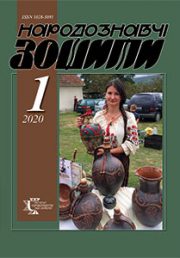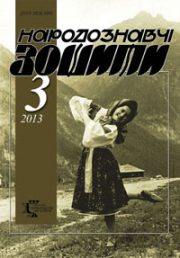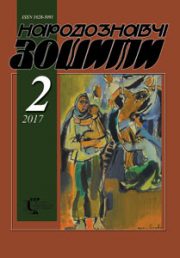The Ethnology Notebooks. 2025. № 4 (184), 883—899
UДК: 624.011.1:728.67]:694(477.4-89)
DOI https://doi.org/10.15407/nz2025.04.883
RADOVYCH Roman
- ORCID ID: http://orcid.org/0000-0002-1900-8948
- Doctor of Sciences in History, Senior Researcher
- of the Institute of Ethnology
- of the National Academy of Sciences of Ukraine,
- in the Department of Historical Ethnology,
- 15, Svobody Avenue, 79000, Lviv, Ukraine,
- Contacts: e-mail: radovychroman@gmail.com
Abstract. Although traditional housing in the Middle Dnipro region has repeatedly served as the subject of scholarly research, a number of issues related to the techniques and technologies of construction have remained outside their focus. This very fact defines the relevance of our study.
In this work, the author sets out to clarify the characteristics of the techniques and technologies of traditional residential construction (especially wooden: log and frame board) in the right bank part of the Middle Dnipro region. The object of the study is vernacular housing, and the subject is the technique and technology of wall construction. The methodological basis of the research is the principle of historicism combined with elements of structural functional analysis and the use of primary methods of ethnological science: retrospective, typological, comprehensive analysis, historical reconstruction, and so on.
The research territory covers the right bank part of the Middle Dnipro region, including Cherkasy, the southern part of Kyiv, the eastern outskirts of Zhytomyr and Vinnytsia regions, as well as the northern outskirts of Kirovohrad region. The chronological scope of the study spans from the mid 19th to the first half of the 20th century.
The source base of the work includes the author’s field materials collected in the Korsun Shevchenkivskyi (2008), Kaniv, Cherkasy (2009) districts of Cherkasy region and in the Volodarsky district (2012) of Kyiv region. At the same time, to achieve the research goal, a considerable array of scientific literature and sources was involved, including the field research of contemporary Ukrainian scholar Zoia Hudchenko concerning folk construction on the right bank of the Middle Dnipro region.
Keywords: Middle Dnipro region, construction technique, walls, log, frame, wattle.
Received 10.07.2025
REFERENCES
- Fundukley, I. (1852). Statistical description of the Kiev province (Part 1). SPb.: In printing houses of the Ministry of Internal Affairs [in Russian].
- Zelenin, D.K. (1915). Description of the manuscripts of the scientific archive of the Imperial Russian Geographical Society (Issue 2, pp. 485—988). Petrograd: Printing house A.V. Orlov [in Russian].
- (2022). Ukraine of the 18th century. in the drawings of Johann Heinrich Munz. Compiled by Taras Chkhlib. Kyiv: Art [in Ukrainian].
- De la Flies, D.P., Boryak, H., & Dashkevich, Ya. (1999). Albums. (Vol. 2). Kyiv: Institute of Ukrainian Archeography and Source Studies named after M. Hrushevsky National Academy of Sciences of Ukraine [in Ukrainian].
- Krymskyi, A. (1930). Zvenyhorodschyna. Shevchenko’s homeland from an ethnographic and dialectological perspective (Part 1, issue 1). Kyiv [in Ukrainian].
- Hrushevskyi, M. (2002). From the life of peasants in the Chihyryn region. Sights of Ukraine: history and culture, 2, 127—135 [in Ukrainian].
- Svyryda, R. (2009). Traditions of folk construction. Shevchenkivskyi region (Pp. 350—363). Kyiv [in Ukrainian].
- Svyryda, R. (2013). Monuments of folk construction of the forest-steppe Kyiv region and the National Museum of Folk Architecture and Life. Problems of preservation, reproduction and popularization of historical and cultural Heritage in the context of open-air museums (Vol. 1, pp. 252—262). Lviv: Apriori [in Ukrainian].
- Kosmyna, T. (1986). Traditions and innovations in the architecture of the people’s of Kyiv and Kyiv Region. Etnography of Kyiv and Kyiv Region: Traditions and Modernity (Pp. 157—200) Kyiv: Naukova dumka [in Ukrainian].
- (2020). Ethnographic image of modern Ukraine. Corpus of expeditionary folklore and ethnographic materials. People’s housing culture. Ecology and organization of habitat (Vol. 9) [in Ukrainian].
- Markovich, J. (1798). Notes on Malorossiya, its inhabitans and products (Part 1). SPb.: under the Provincial Board [in Russian].
- Chubynsky, P.P. (1877). Russians of the South-Western Territory: housing, utensils, farm buildings and tools. In: Proceedings of the ethnographic and statistical expedition to the West Russian Region, equipped with the Russian Geographical Society of the South-West Division (Vol. 7, issue 2, pp. 339—606). SPb. [in Russian].
- Radovych, R. (2017). Polissya dweling: cultural and genetic origins and evolutionary processes. Lviv [in Ukrainian].
- Radovich, R. (2012). Traditional housing in the north of ethnographic Volhynia: features and Volyn Polissya parallels (late 19th — early 20th c.). The Ethnology notebooks, 2, 201—217 [in Ukrainian].
- Radovych, R. (2015). National architecture Staryi Sambir district in the nineteenth — first half of the twentienth century (housing and economic complex) [in Ukrainian].
- Hupalo, K.N. (1982). Podil in Ancient Kyiv. Kyiv: Naukova dumka [in Ukrainian].
- Rusov, A.A. (1899). Description of the Chernigov province (Vol. 2). Chernigov: Printing House of the Provincial Zemstvo [in Russian].
- Radovich R. (2021). Techniques and technology of wall construction of dwellings in the Zolotonosha region (in the context of the residential construction culture of the left bank Middle Dnipro region). The Ethnology notebooks, 6, 1483—1506) [in Ukrainian].
- Kosmyna, T. (1999). Stellement, mansion, housing. Ukrainian: Historical and ethnographic monography: in two books (Vol. 2, pp. 13—57). Opishne: Ukrainian Genre Studies [in Ukrainian].







